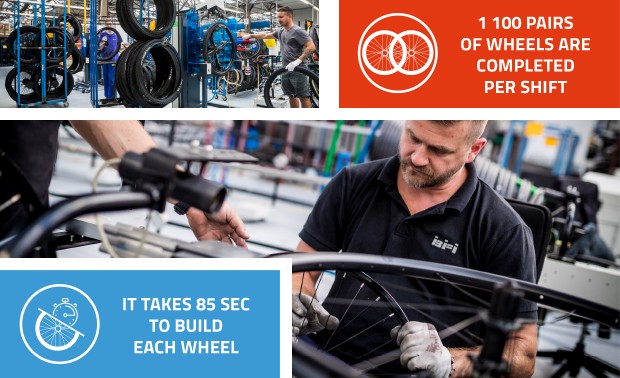Wheel building
Wheel building is a demanding process and at Bike Fun International (BFI) we consider it one of the key elements. Our wheel building process includes the following steps
Material preparation
In this initial step we focus on the precise preparation of all the components required for wheel building:
- Tyre and tube preparation: We start by preparing the tyres and tubes.
- Unpacking and inspection: Key components such as cassettes, hubs, reflectors, and valves are carefully unpacked and thoroughly inspected. This ensures that all parts are in perfect condition and ready for the subsequent stages of the manufacturing process.
- Identification labels and rim adhesion: We pay attention to every detail. We prepare essential labels for correct identification and rim adhesion.
- Quality control and handling of claims: Quality is our first priority. We carry out a thorough inspection of all materials and components to ensure that the parts used are flawless. If, by chance, defective components are found, we deal with their claims and replacements promptly.
Rim preparation
This involves unpacking the rims and carrying out a visual inspection. We then carefully apply labels to the rims. We also unpack the roller brakes and prepare all the necessary components for final assembly.
Spoking
Our manual work begins at this stage, where we precisely fit the spokes into the hub according to a set procedure. The spoking process is the same for all types of hubs.
Wheel Lacing and Centering
For wheel lacing we use ISL automatic machines from the renowned Dutch brand Holland Mechanics. The crucial moment, however, is the manual connection of the spokes to the rim using nipples. This is followed by automatic taping and wheel stabilisation. We use SG robots to centre the rims to the required parameters. The robot first checks the balance of the wheel, then tightens the spokes to achieve the desired wheel strength, and finally centres the wheel to achieve the highest quality.
Tyre mounting
After the wheel has been laced and centred, the tubes and tyres are fitted to the ends of the spoke lines using TMC tyre changers. Once this stage is complete, the laced wheel is ready for final assembly. We place great emphasis on the quality of every laced wheel and every step of the manufacturing process is carried out with precision and care.
We can make 1100 pairs of wheels during an eight-hour shift. Building of one wheel on average takes between 70 and 80 seconds-depending on the complexity of the spokes layout.





